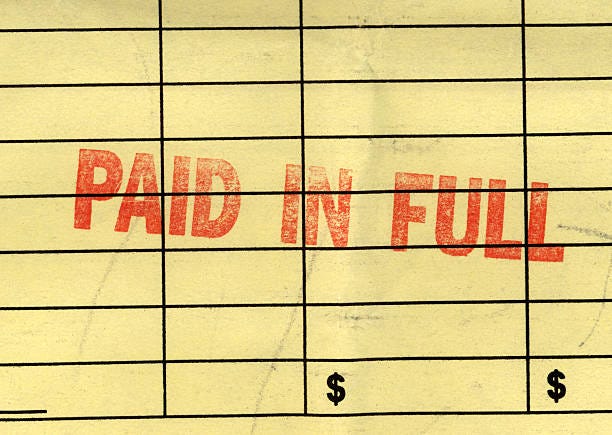The Greek word tetelestai (τετέλεσται) means to end, to bring to completion, to accomplish, to fulfill, to finish. It comes from the Greek root word telew, meaning coming to and end, to finish, or complete. Like most words, when conjugated into different tenses tetelestai’s meaning is nuanced given the particular context. Let’s take a look.
» In ancient Greece, when a servant was given a mission to accomplish, upon return to their master they would say, tetelestai—meaning “mission accomplished,” I have done exactly what you requested. It is finished!
» The word tetelestai is also a legal term used to confirm that a debt had been satisfied. Once a final payment was rendered, the parchment recording the debt (the modern-day promissory note) was stamped with tetelestai, or “paid in full.” Simply put, it is finished!
» In ancient Israel and according to the Mosaic law, Jews would bring their prescribed animal sacrifices to the temple on the annual Day of Atonement to obtain the temporary forgiveness of sin (lasting for one year). In the sacrificial system, the high priest received the sacrifices, moved behind the veil in front of the Ark of the Covenant, and poured the blood on the mercy seat, or the golden lid placed atop the Ark. When the sacrificial blood made contact with the mercy seat, atonement was made for the sins of those offering the sacrifice. The high priest would conclude the process by saying tetelestai (in the Hebrew equivalent): the sacrifice is complete and the sin debt was now paid for another year. The priest proclaimed that it is finished!
» According to the Holy Scriptures, as Jesus hung on the cross, his final utterance before dying was tetelestai, it is finished. Then he bowed his head and gave up the ghost, meaning his soul was disconnected from his body. The purpose for which Jesus was crucified had been accomplished. It was finished!
For those less familiar with the Scriptures, here’s a very quick summary of the mission Jesus Christ accomplished on the cross.
Arguably the most famous Bible verse is John 3:16:
For God so loved the world, that he gave his only begotten Son, that whosoever believeth in him should not perish, but have everlasting life.
But the next verse, John 3:17, closes the deal:
For God sent not his Son into the world to condemn the world; but that the world through him might be saved.
For God to accomplish this, He incarnated himself and entered the human domain as the person of Jesus Christ, His only begotten (not made) son. This realized the fullness of the second part of the holy trinity (one God, three offices):
(1) God the Father
(2) God the Son, and
(3) God the Holy Spirit.
Because Jesus was God incarnate, He could live a sinless life ensuring he was “without spot or wrinkle” and sufficient to serve as a blood sacrifice for the atonement of sin. By the command of God the Father, Jesus Himself, God the Son in human form (instead of a sacrificial lamb, goat, or ram) bore the sins of the world and, through His perfect blood, secured eternal redemption for all who believe that His sacrifice does indeed atone for human since once and for all.
Christ’s death, burial, and resurrection didn’t remove sin from the world (that will come later) and wasn’t intended to, but it overcame our penalty for sin by paying its wages—death, or eternal separation from God—in full so that we may have life everlasting in the new heavens and new earth (that will also come later). Moreover, His death, burial, and sacrifice gave us power over sin in our lives, something too often disregarded in Christendom.
When Jesus was on the cross, He was both the sinless sacrifice whose blood was shed and the High Priest proclaiming tetelestai, it is finished, the sacrifice is complete. The shedding of His blood fully and finally fulfilled all of the requirements of the Mosaic law and ended the sacrificial system.
When Christians speak of “Christ’s finished work on the cross,” this is what they’re referencing. Because of His sacrifice, we have been freed from the requirements of the Mosaic law to seek atonement for sin through the sacrificial system. Instead, we are invited to trust in the sufficiency of His blood not just for the annual forgiveness of sin, but for permanent forgiveness of sin. Those who accept His free offer of eternal redemption by trusting in His finished work on the cross will spend eternity with Him; those who decline will spend eternity without Him. This, my friends, is the gospel, the “good news.”
A Christian Homegoing
My mother-in-law, Patricia, was believing Christian so it’s natural that her funeral reflected her beliefs. Our local pastor, who presided over the service, knew Pat for over a decade and was intimately familiar with our small family’s valiant years-long effort to make intergenerational living work well (Pat, Chris, and me under one roof). Having a tender-hearted, trusted friend and family insider deliver the funeral message comforted Chris and me at a difficult time.
Some background ….
Chris and I purchased our home in 2010 intending to move in Chris’ mom once managing a single-family home became too much for her, which happened in 2013. The arrangement was well-planned (at least on paper) but it wasn’t a “natural” fit for any of us. Nonetheless, we each committed to the new normal. As one might expect, intergenerational living had its highs and lows, ups and downs, and rights and lefts (for each of us), but it also came with some very quirky comic relief. You just can’t make some of that kind of funny up!
For some added context, my MIL never logged onto a computer, sent or received an email, or sent or received a text message during her natural life. She was all analog, all the time. We tried in earnest to help her make the “digital” leap, but once you realize you’re in a hole, it’s usually best to stop digging!
If my MIL and I had one thing in common, it was our mutual love and adoration for Chris. Pat was widowed in 1995. Her husband, John, was just 58 when he succumbed to cancer. She was 57 and Chris was 23. I never knew my father-in-law, but I learned about him through the memories Pat and Chris shared over hot pots of coffee and photo albums. And, I will continue to learn about him ….
Chris also didn’t know his father-in-law, my dad, as he passed away the year before Chris and I met. Dad was 68, I was 32. Chris and I bonded early over the shared burden of paternal loss, but our respective widowed mothers grieved their husbands differently from us, their kids, and each other. In some ways, even though Chris’ dad passed away 12 years before I entered the picture, his death was still fresh for Pat. Looking back, I don’t think the wound ever fully healed while she was on this side of eternity. The wound would scab, then rip open, scab, then rip open again, and continue in a perpetual yet unpredictable cycle. I was trying to build a relationship with Pat, Chris’s mom, but in reality, at least in the early years, I was building a relationship with John’s widow. It was new territory for me.
My mom, on the other hand, did most of her grieving before my dad died as he was sick for nine (9) years; Chris’ dad was sick for nine (9) months. A few months after my dad’s death, I asked my mom why she wasn’t “sadder” than she appeared. Her response was poignant. It went something like this:
Kelley, I began mourning the loss of my marriage nearly a decade ago when your father’s mind started to go. And, his death freed him from the prison of his life which witnessed a broken mind and, ultimately, broken body. His spirit, which had been eternally secured through faith in Christ, had gone home (to heaven) and that gives me great peace. Watching him suffer was a horror show. My tears no longer flow since the nightmare for him—and for me—has finally ended. It is finished.
Admittedly, it was weird to witness the quick pace of my mom’s recovery, but I wasn’t my dad’s caregiver, nor was I his wife. She had her journey and I, his daughter, had mine. Giving each other space to grieve in unique ways is the greatest gift a family gives itself after losing one of its own—one we learned the hard way.
A Grieving Widow
When I first met Pat, I had no idea I’d be meeting a still-grieving widow. Given my non-experience with grieving widows, I was way out of my league. I didn’t understand the immediacy of her pain and was ill-equipped to engage it productively. I just loved her son and wanted her to know that.
Naturally, once we joined households, there were some hits and misses, but over time she and I found our battle rhythm. Initially, our mutual love for her son was both an area of tension and a source of bonding so it took some time to find stasis; he was the man in her life, and the man in mine. In time, it became a powerful point of connection. As Pat moved into the sunset of her life, my empathy deepened and I tried to see the world through her eyes instead of mine—less of me and more of her. It was a game-changer and one of many legacies she leaves behind.
I loved my mother-in-law for many reasons, but primarily because she birthed and nurtured an honorable, dignified, and delightful son who, 17 years ago, became the love of my life. And she did so despite enduring numerous tragedies not discussed here.
You see, without Pat, there is no Chris. And without Chris, there is no Kelley and Chris. And without Kelley and Chris … well, that’s a reality I can’t bear to imagine.
A Hope Chest
Just before the close of the funeral service, our (and Pat’s) pastor committed her body to the ground. Committals for Bible-believing Christians usually go something like this:
For as much as it has pleased Almighty God to take out of this world the soul of Pat Keller, we therefore commit her body to the ground, earth to earth, ashes to ashes, dust to dust, looking for that blessed hope when the Lord Himself shall descend from heaven with a shout, with the voice of the archangel, and with the trump of God, and the dead in Christ shall rise first. Then we which are alive and remain shall be caught up together with them in the clouds to meet the Lord in the air, and so shall we ever be with the Lord, wherefore comfort ye one another with these words.
Just before Pat’s committal, our pastor placed his hand on the casket holding her remains, but he didn’t call it a casket, instead referring to it as a hope chest since, for believers, hope upon physical death is a sure thing.
According to the Scriptures, on an appointed day in the future known only to God, Pat’s remains, along with those of every other deceased believer, will be resurrected from the grave and ascend to meet Christ in the air during what we, in modern parlance, call the rapture.
In the Apostle Paul’s first letter to the church in Thessalonica, he records the details of God’s specific revelation given only to him regarding the rapture, which also serves as the inspiration for Christian committals as noted above.
Here’s the text of 1 Thessalonians 4:13-18 from the King James Bible:
13 But I would not have you to be ignorant, brethren, concerning them which are asleep, that ye sorrow not, even as others which have no hope.
14 For if we believe that Jesus died and rose again, even so them also which sleep in Jesus will God bring with him.
15 For this we say unto you by the word of the Lord, that we which are alive and remain unto the coming of the Lord shall not prevent them which are asleep.
16 For the Lord himself shall descend from heaven with a shout, with the voice of the archangel, and with the trump of God: and the dead in Christ shall rise first:
17 Then we which are alive and remain shall be caught up together with them in the clouds, to meet the Lord in the air: and so shall we ever be with the Lord.
18 Wherefore comfort one another with these words.
Indeed, as we looked upon Pat’s “casket,” we understood it was so much more than a box holding her mortal remains. It was (and is) a hope chest that will one day be emptied as her sleeping body rises to meet the Lord in the air. But, for now, she will rest next to her husband, John, who will also rise at the rapture alongside her.
Note that everyone has an eschatology, or a view of last things, such as the end of humanity, the end of time, and even the end of the world itself, even if it’s not well-developed. Christians, Jews, New Age spiritualists, Jehovah’s Witnesses, Wiccans, Mormons, Atheists, and so forth all have an eschatological position. For example, William Godwin, Mary Wollstonecraft’s husband, declined to attend her funeral since in 1797 since, as an atheist, he didn’t believe in any form of existence after physical death so there was no reason for him to attend.
Believing Christians, defined as those who believe in historic Christianity (including the inerrancy and infallibility of the Scriptures) naturally trust Biblical revelation to inform their views of the end times. It may sound wacky to non-Christians, but, similarly, other worldviews sound wacky to Christians - something we’ll unpack in the future. So, before condemning someone for what you may believe are irrational or unsubstantiated beliefs, take some time to question the assumptions on which their - and your - views rest, and exercise some empathy along the way.
It is Finished
At the last minute, Chris decided not to deliver a eulogy. He wanted to avoid any distractions that could diminish his ability to be fully present while imbibing the hope that his mom’s passing symbolized, not just for him and her loved ones (including me), but for everyone in attendance. It was an excellent choice.
Pat’s funeral was a celebration not only of her life, but also of her spiritual homegoing, her eternal security, and the sure hope that we will meet again. It was an honorable sendoff for a brave woman who fought the good fight and finished her race, with dignity and grace.
Once the pastor concluded the committal, the funeral home’s representative invited the attendees to choose a flower from the beautiful spray atop Pat’s hope chest and pay their last respects. The gathering was informal, as graveside services tend to be, so people slowly made their way forward without fanfare. During this time, I met many who knew Pat as a small girl, a young wife, a new mother, and/or a young widow. The names were familiar but the faces were new. It was a full-circle moment.
The long days just before Pat’s passing were finished, the funeral preparations were finished, and the public goodbyes were finished. But, most poignantly, Pat’s earthly journey was finished. She, too, had given up the ghost and her spirit, having been separated from the body, is now free in the Lord.
Tetelestai, it is finished!
In Loving Memory of “Ma”
Patricia F. Keller (March 17, 1939 - July 2, 2024)
xo,
Kelley











What a beautiful and poignant presentation and application of the Gospel. Hope chest indeed. I love it.
Amen and Amen